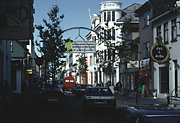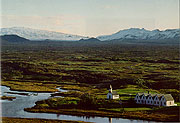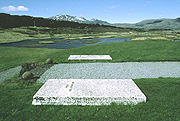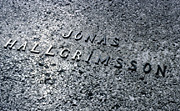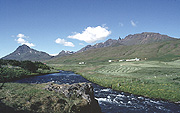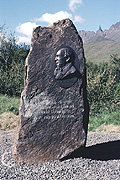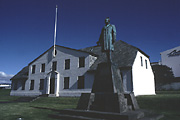II. Biographical Sketch of Jónas Hallgrímsson
9. Afterward
Þorsteinn Gíslason noted in 1903 that Jónas had died like Moses,
leaving the band of his contemporaries on the edge of a mountain overlooking the Promised Land, the land of the future which they longed to inhabit: Iceland as they imagined it ought to be — and
might be. (
JH12)
The summer after Jónas's death the restored Alþing met for the first time in Reykjavík and there, the following year, the new school — at which he had so desperately wanted to teach natural science — opened its doors. Subsequently, by gradual steps, Iceland achieved full independence from Denmark and became the prosperous nation it is today.
Jónas's role in all this, and the genius of his poetry, only slowly attained wide recognition. At first it seemed as if everything had been in vain.
What did he gain from all his anxious hours?
Iceland's ingratitude and nothing more:
he with his fervent love for Iceland's flowers,
her fjords and valleys and her rugged shore,
her landscape pulsing with mysterious powers.
He touched his lyre — could hymns in heaven be fairer?
We heard him singing, but did not attend.
Pitiful men! not knowing — plunged in error —
a poet's voice is God's voice, in the end,
whether he sings of sorrow, bliss, or terror.
|
Því, sem að Ísland ekki meta kunni,
er Ísland svipt; því skáldið hné og dó,
skáldið, sem því af öllu hjarta unni,
sem elskaði þess fjöll og dali og sjó
og vakti fornan vætt í hverjum runni.
Þegar hann hrærði hörpustrenginn sæta,
hlýddum vér til, en eftirtektarlaust,
vesalir menn, er gleymdum þess að gæta,
að guð er sá, sem talar skáldsins raust,
hvort sem han vill oss gleðja eða græta. (9F73)
|
These are the first two stanzas of the other memorial poem published in the last issue of Fjölnir in 1847. It is not signed and its authorship is uncertain.133
In addition to Konráð's prose remembrance and the two memorial poems, the last issue of Fjölnir, which was consecrated to Jónas's memory, contained an incomplete (but extremely important) list of works that he had published during his lifetime, and also a number of unpublished pieces of prose fiction that Brynjólfur and Konráð had found among his papers after his death. They also found the manuscripts of many unpublished poems from all periods of their friend's life, and that same year (1847) they pooled them with the poems already printed in Fjölnir and Skírnir to produce the first collected edition of Jónas's poetry, A.134
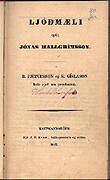
[larger image]
|
Title page of the first collected edition of Jónas's poems. |
Other editions followed: B in 1883 (in addition to Jónas's poetry, it contains the prose pieces printed in the last issue of Fjölnir, and also the extremely important biographical sketch of Jónas by Hannes Hafstein,135 based largely on information supplied by Konráð, Páll Melsteð, and Steenstrup [BVII]); C (the least important edition) in 1913; D (the first truly scholarly edition of most of Jónas's writings, in five volumes) in 1929-37; and E (the most recent scholarly edition, in four volumes) in 1989.136
In 1907, on the hundredth anniversary of Jónas's birth, a bronze statue by the sculptor Einar Jónsson was unveiled;137 it stands today next to The Pond (Tjörnin) in downtown Reykjavík. In 1946 Jónas's remains were disinterred from their original grave in Copenhagen and brought to Iceland, where they were reburied in the poets' corner (skáldareitur) behind the church at Þingvellir, in the midst of the majestic scenery that had nestled the old Alþing and that Jónas had celebrated in his poem "Mount Broadshield."
In 1996 a roadside park — Jónas Memorial Grove (Jónasarlundur) — was dedicated in Öxnadalur, on the land of the farm Steinsstaðir where Jónas had grown up. A memorial stone was raised in the same place a year later.
Notes
133 Matthías Þórðarson thought (logically enough) that it is the poem by Gísli Thorarensen read at the last meeting of the Fjölnir Society on 19 May 1847 and accepted for publication by acclamation (33Eim195 and n). Others have thought it was by Konráð Gíslason (see for example Na355n1).
134 Benedikt Gröndal wrote out the copy for the printer (4BGR388). The work on this edition was done between January and May 1847 (see BPB111, 117) and was very much a labor of love. Brynjólfur wrote Grímur Thomsen on 9 July: "You'll have seen in the Danish papers that the poems of Bjarni Thorarensen and Jónas Hallgrímsson have been published, both poets in meticulously careful editions, but especially the latter. This will come as no surprise to you when you learn that Konráð and I were the ones responsible" (BPB122).
135 Hannes (1861-1922) did the work on this edition of Jónas while a student at Copenhagen University. He later went on to be a considerable poet himself and also Prime Minister of Iceland for two terms (1904-9, 1912-4). His statue stands today in front of Government House in Reykjavík.
136 There have also been a number of popular editions. But these have not contributed to establishing the text or fundamental interpretation of Jónas's work.
137 For details of the celebrations that accompanied this unveiling, see Huginn, 1. árg., 11 tbl. (21. nóv. 1907), 41-3.


